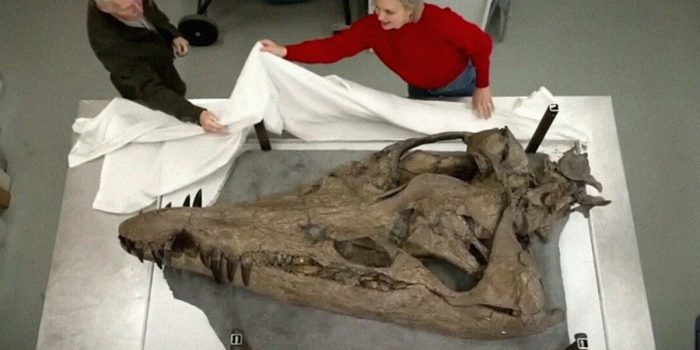In a remarkable discovery along the Jurassic Coast near Dorset, UK, scientists uncovered the massive skull of a “colossal sea monster,” believed to be a pliosaur, a marine reptile that inhabited the oceans around 150 million years ago. Measuring an imposing six feet and five inches across, the exceptionally well-preserved skull provides a rare opportunity to gain insights into the creature’s life and predatory behavior.
“It’s one of the best fossils I’ve ever worked on,” local paleontologist Steve Etches told the BBC. “What makes it unique is it’s complete.”

Local paleontologist Steve Etches expressed his astonishment, describing it as “one of the best fossils I’ve ever worked on” due to its completeness. Pliosaurs, which could reach lengths of around 40 feet, were formidable apex predators with razor-sharp teeth capable of tearing prey into pieces. Comparing it to an underwater T-Rex, Bristol University paleobiology PhD student Andre Rowe highlighted the massive size of the creature, suggesting it could effectively prey on anything in its vicinity.
“The animal would have been so massive that I think it would have been able to prey effectively on anything that was unfortunate enough to be in its space,” Bristol University paleobiology PhD student Andre Rowe told the BBC.
“I have no doubt that this was sort of like an underwater T-Rex,” he added.
Pliosaurs possessed powerful jaws that could generate an estimated 33,000 newtons of force, surpassing the bite force of a saltwater crocodile and approaching two-thirds of a T-Rex’s bite force. This strength allowed them to incapacitate prey and effectively crunch through tissues and bones. The discovery was made by fossil enthusiast Phil Jacobs, who noticed the tip of the snout protruding from a cliff face along the fossil-rich Jurassic Coast.
“If you can generate a really powerful bite, you can incapacitate your prey; it’s less likely to get away,” University of Bristol palaeobiologist Emily Rayfield told the BBC. “A powerful bite means you’re also able to crunch through tissue and bone quite effectively.”

The recovery of the colossal skull proved to be a challenging endeavor, requiring an international team of scientists several months to extract it from the rock. The skull’s completeness is particularly significant for researchers aiming to reconstruct the pliosaur’s anatomy and understand its role as a top predator in prehistoric oceans.
Despite the skull’s retrieval, the quest for more remains continues, with Etches expressing confidence that the rest of the creature is likely present in the rapidly eroding environment. The location along England’s southern coast, known for its fossilized remains embedded in rock, holds the promise of unveiling additional bones in the future. This discovery stands as a valuable contribution to paleontological knowledge, shedding light on the mysteries of Earth’s ancient marine ecosystems.


